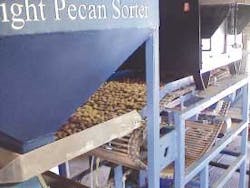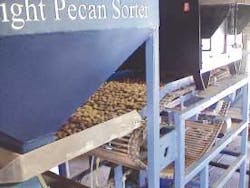Produce sorting and inspection require evolving vision systems
A discussion with Roger Holt of Inspection Masters
VSD:What market changes are driving the implementation of new technologies that Inspection Masters chooses for produce sorting and inspection applications?
Holt: Market changes and customer demands pretty much strike at the center of what Inspection Masters is all about. We started out just scratching a personal itch. My partners own pecan orchards and began feeling the pinch of a rising minimum wage, growing workers’ compensation claims, and an increasing lack of seasonal workers in their processing plant. This sentiment was shared throughout the industry.
We set out to develop a vision system that would replace the seasonal labor pool. Seven years later our systems are deployed throughout the pecan industry, and we are developing new products for other, similar industries. The interesting thing about our entrance into the machine-vision arena is that timing was everything. Systems that sort items such as computer chips or contact lenses can command a fairly high price tag. But when you sort items with a very low value-per-item point and only use the system for a fraction of a year, the machine-vision system must be relatively inexpensive with a very high throughout. The price of components and speed of processing both went the right direction in the past few years.
VSD:How is Inspection Master using OEM peripherals such as frame grabbers, lighting software, and other off-the-shelf components? In the inspection of food products, how is each component more or less important for each application?
Holt: Inspection Masters is essentially an OEM of components with a bit of ingenuity and a good ear for customer needs. We utilize cameras, frame grabbers, I/O devices, optics, lighting, a computer system, and software, along with a mechanical delivery and ejection system to provide inspection and separation of product.
Our machines continually evolve as technology changes. In the past we used analog cameras and frame grabbers. Then we turned to digital cameras and dedicated digital frame grabbers. We now exclusively use digital cameras with standard FireWire cards.
Since we needed near-infrared (IR) illumination, we had used a halogen-based lighting system but that created a lot of heat. Now near-IR LEDs are sufficient for our use.
VSD:What technologies and components does Inspection Master use in your applications?
Holt: We are currently using Basler (Ahrensburg, Germany; www.baslerweb.com) 600 series FireWire cameras and generic IEEE 1394 cards. We also use some I/O devices from National Instruments (NI; Austin, TX, USA; www.ni.com) and some from CyberResearch (Branford, CT, USA; www.cyberresearch.com). We custom-manufacture our own LED lighting arrays and build our own computer systems with Windows 2000 and XP operating systems because real-time systems are expensive and not required. I like the NI Compact Vision System for its reliability and deterministic processing, but it is too limited in I/O.
VSD:In which areas do you see the most growth? What are users demanding from you in the design of your systems?
Holt: Everything is getting faster and cheaper. Five years ago we had a machine called a PS-3000, reflecting the fact that it would process 3000 pounds of product per hour. The same product today is called PS-10,000-and you guessed it, it processes 10,000 pounds per hour! It sells for the same price as the earlier version.
In the food industry we are looking more at textures and densities than specific shapes or whether items are present or not present. Therefore sensors, lighting, and optics are extremely important. And different applications have varying wavelength requirements.
Equally as important is having a versatile software program. We are a company that is conducting R&D on many different applications. These targets can vary in every way imaginable. We need a software program that is powerful, able to capture and analyze anything, versatile, can interface a variety of I/O devices, and, finally that is evolving to keep pace with the everything else going on.
As a result, we “hitched our wagon” to a company that promised one-stop-shopping integrated software, processing, and I/O capabilites. After a couple years of poor documentation and worse customer support-not to mention a fragile company structure and later merger with another company-we cut our losses with that company and switched to National Instruments LabView software. That was the best decision in our company’s history.
VSD:How do you envision the future of imaging in the industries you serve? What kinds of new applications do you expect to emerge?
Holt: We are keeping a close eye on high-resolution cameras as the prices go down and the computer processing power goes up. We’re also very interested in IR cameras and x-ray sensors.
I see the future of machine vision as just the second wave of the industrial revolution. I think that as the technology grows and costs go down, every facet of every industry will find applications for machine vision.
ROGER HOLT is president of Inspection Masters (Tularosa, NM, USA; www.inspectionmasters.net), which he cofounded in 2001. He has a B.S. in education and another in electrical/computer engineering. He has been a contractor to NASA and has designed imaging and control systems for the US Strategic Defense Initiative. Editor in Chief Conard Holton talked to him about sorting and inspection systems for the food-processing industry.


